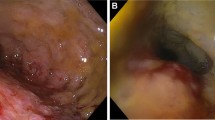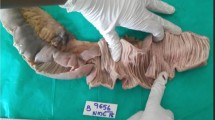Abstract
We experienced a case of intestinal strongyloidiasis complicated by jejunal carcinoma. A Japanese male in his 50s, who has a 7-year medical history of duodenal ulcers, complained of loss of appetite, nausea, vomiting and diarrhea. Computed tomography and gastroduodenal endoscopic examination revealed a stenosis of the duodenum. To remove the stenosis, gastric bypass surgery was performed. The pathological diagnosis of the resected jejunum was strongyloidiasis and well-differentiated adenocarcinoma with subserosal invasion and vascular infiltration. After administration of Ivermectin, Strongyloides stercoralis was not found in any biopsies or in the specimens of the intestine, which were resected due to cancer recurrence 2 years later. There are three possibilities for the reason of coexistence of S. stercoralis and adenocarcinoma: S. stercoralis caused the adenocarcinoma, S. stercoralis moved to the carcinoma, or just coincidence. Although it is difficult to prove a causal relationship between S. stercoralis and adenocarcinoma, this is the first report of adenocarcinoma developed in the jejunum with chronic strongyloidiasis. The number of nematode infections, including strongyloidiasis, is decreasing in Japan, although not worldwide. Therefore, it should be considered in patients with prolonged intestinal ulcers.



Similar content being viewed by others
References
Verweij JJ, Canales M, Polman K, et al. Molecular diagnosis of Strongyloides stercoralis in faecal samples using real-time PCR. Trans R Soc Trop Med Hyg. 2009;103:342–6.
Dorris M, Viney ME, Blaxter ML. Molecular phylogenetic analysis of the genus Strongyloides and related nematodes. Int J Parasitol. 2002;32:1507–17.
Tanaka T, Hirata T, Parrott G, et al. Relationship among Strongyloides stercoralis infection, human T-cell lymphotropic virus type 1 infection, and cancer: a 24-year cohort inpatient study in Okinawa, Japan. Am J Trop Med Hyg. 2016;94:365–70. doi:10.4269/ajtmh.15-0556.
van Tong H, Brindley PJ, Meyer CG, et al. Parasite infection, carcinogenesis and human malignancy. EBioMedicine. 2016;S2352–3964:30551–5. doi:10.1016/j.ebiom.2016.11.034.
Gabet AS, Mortreux F, Talarmin A, et al. High circulating proviral load with oligoclonal expansion of HTLV-1 bearing T cells in HTLV-1 carriers with strongyloidiasis. Oncogene. 2000;19(43):4954–60.
Seo AN, Goo YK, Chung DI, et al. Comorbid gastric adenocarcinoma and gastric and duodenal Strongyloides stercoralis infection: a case report. Korean J Parasitol. 2015;53:95–9. doi:10.3347/kjp.2015.53.1.95.
Tomaino C, Catalano C, Tiba M, et al. A first case report of colorectal cancer associated with chronic Strongyloides stercoralis colitis and the complex management decisions that follow. Gastroenterology. 2015;148:S575. doi:10.1016/S0016-5085(15)31941-7.
Chien LN, Huang YJ, Shao YH, et al. Proton pump inhibitors and risk of periampullary cancers—a nested case–control study. Int J Cancer. 2016;138:1401–9. doi:10.1002/ijc.29896.
Hirotsu T, Sonoda H, Uozumi T, et al. A highly accurate inclusive cancer screening test using Caenorhabditis elegans scent detection. PLoS ONE. 2015;10:e0118699.
Nakamura N, Matsushita M, Takashi Y, et al. Diagnostic yield of double-balloon enteroscopy with intestinal juice analysis for intestinal strongyloidiasis. Dig Endosc. 2010;22:370–2.
Author information
Authors and Affiliations
Corresponding author
Ethics declarations
Conflict of interest
S. Ishikawa, T. Maeda, K. Hattori, T. Watanabe, T. Kuramoto, S. Ueno, G. Ueno, T. Yamada, A. Kanazawa, M. Sakaguchi, Y. Tsukamato declare that they have no conflict of interest.
Human rights
All procedures followed have been performed in accordance with the ethical standards laid down in the 1964 Declaration of Helsinki and its later amendments.
Informed consent
Informed consent was obtained from the patient to be included in the study.
Rights and permissions
About this article
Cite this article
Ishikawa, S., Maeda, T., Hattori, K. et al. A case of adenocarcinoma developed in the small intestine with chronic strongyloidiasis. Clin J Gastroenterol 10, 519–523 (2017). https://doi.org/10.1007/s12328-017-0783-7
Received:
Accepted:
Published:
Issue Date:
DOI: https://doi.org/10.1007/s12328-017-0783-7




